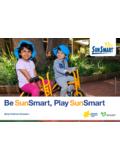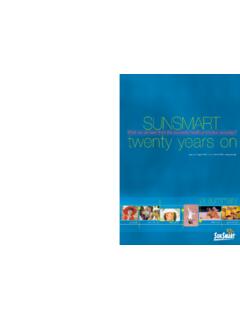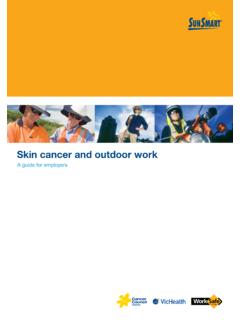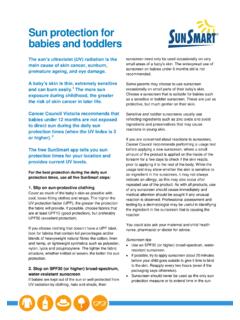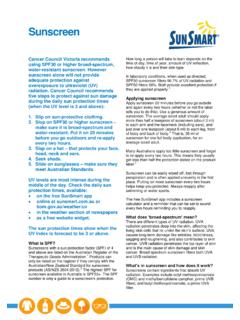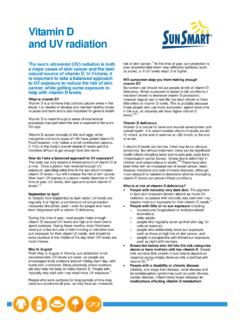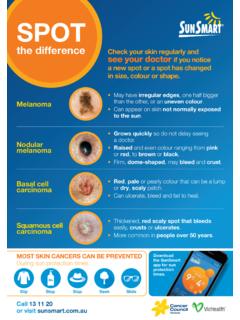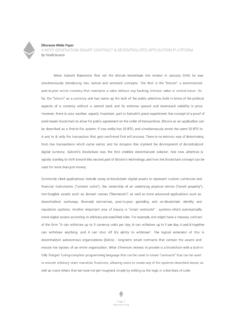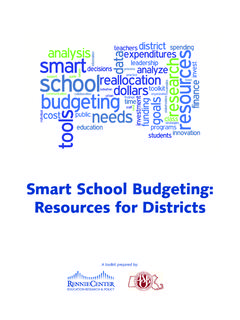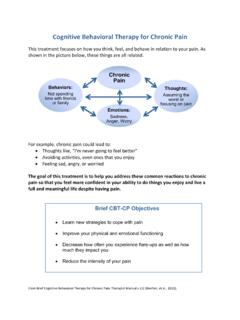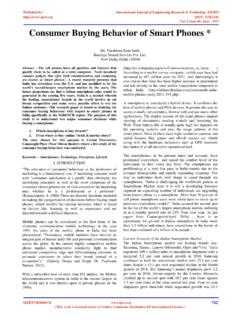Transcription of Be SunSmart, Play SunSmart
1 Be SunSmart , Play SunSmartEarly Childhood ResourceImage courtesy Cancer Council WA2 | Be SunSmart , Play SunSmartAbout this resourceParticipating in an early learning service either a childcare centre, family day care service, kindergarten or playgroup can offer children many good opportunities to learn important lessons that will stay with them throughout their lives. This learning sometimes occurs in planned activities. However, powerful learning also happens at other times, as children interact with each other and with adults and go about their daily lives the concepts of Being, Belonging and Becoming The Early Years Learning Framework for Australia and the Victorian Early Years Learning and Development Framework, this resource aims to assist early childhood educators to help young children minimise the risk of skin cancer.
2 It provides information to help educators and children know when sun protection is needed, which sun protection measures are best and recommendations about vitamin D. It also outlines some starting points for incorporating SunSmart practices into the play experiences of early childhood programs so all children can develop an understanding of why they are learning these SunSmart SunSmart , Play SunSmartEarly Childhood ResourceSunSmart, Cancer Council Victoria 615 St Kilda Road Melbourne Victoria 3004 Australia Cancer Council Victoria 2011 / 2017 Early childhood educators may copy this material freely for the purpose of educating children, staff, parents, families and others in early childhood services, provided acknowledgement is made of SunSmart , Cancer Council SunSmart , Play SunSmart (2003)
3 Was developed by Sue Elliott in consultation with the National Schools and Early Childhood Working Group, Cancer Council Australia. The 2011 revised version was written by Anne Stonehouse, Justine Osborne and Prue by Kelvin SunSmart4 | Be SunSmart , Play SunSmart2. Slop on SPF30 (or higher), broad-spectrum, water-resistant sunscreen Apply SPF30 (or higher), broad-spectrum, water-resistant sunscreen to any skin unprotected by clothing at least 20 minutes before going outdoors. Re-apply it every two hours or immediately after swimming or sweating even if the sunscreen label says a different time. Most people don t apply enough sunscreen so frequent reapplication is important to get the best level of protection possible.
4 It is recommended that children from about three years are encouraged to apply their own sunscreen under supervision. It is important they are given time to develop this skill so they will be ready for independent application at school. Try setting up a sunscreen station with mirrors, sunscreen and cloths for hand wiping. A pump pack may be easier for children to handle. See SunSmart s How to make your own sunscreen station video. Services can usually save some money if sunscreen is purchased in bulk but make sure there is a long use by date. If a service supplies sunscreen, it is recommended that families are informed of the brand/type and ingredients. Ask families to complete an authorisation form for the application of sunscreen.
5 Some children may be sensitive to some sunscreens, so if the sunscreen the service supplies is not suitable, parents should supply an alternative for their child. If parents have responsibility for providing sunscreen, still ensure the service has some available for unexpected circumstances. The Australasian College of Dermatologists states that because very young babies (less than six months of age) absorb more of any chemical applied to the skin than adults, the widespread regular use of chemical sunscreens is not recommended. However, there have been no reports of side effects occurring as a result of sunscreen absorption in babies to date. The American Academy of Pediatrics has stated that sunscreens may be used on infants younger than six months on small areas of skin if adequate clothing and shade are not SunSmart The sun s ultraviolet (UV) radiation is the main cause of skin cancer.
6 UV damage also causes sunburn, tanning premature ageing and eye good news is sun protection will cut your risk of skin cancer at any age, no matter if you are six months or 60 years protectionAustralia has one of the highest rates of skin cancer in the world. Two in three Australians will develop some form of skin cancer before the age of 70. Sun exposure during childhood has a significant impact on a person s risk of skin cancer. During the daily sun protection times (whenever UV levels are 3 or above refer to page 7) use a combination of these five sun protection measures:1. Slip on sun-protective clothing Cover as much of the child s skin as possible with cool, loose-fitting clothes, and wraps for babies.
7 The higher the UV protection factor (UPF) of the fabric, the greater the protection provided. If possible, choose fabrics that are at least UPF15 (good protection), but preferably UPF50 (excellent protection). When clothing doesn t have a UPF label, look for fabrics that contain full percentages and/or blends of heavyweight natural fibres like cotton, linen and hemp, or lightweight synthetics such as polyester, nylon, lycra and polypropylene. The tighter the fabric structure, whether knitted or woven, the better the protection from UV radiation. Longer style shorts or skirts and tops that cover the shoulders, arms and chest are best. Polo shirts with a collar also help protect the | Be SunSmart , Play SunSmart When choosing a hat consider its size and comfort, the amount of shade it provides to the face, if it will obstruct vision or hearing and safety.
8 Hats that can be adjusted at the crown are best. If the hat is secured with a long strap and toggle, ensure it has a safety snap, place the strap at the back of the head, or trim the length so it doesn t become a choking hazard. Some children do not like to wear hats. Persistence is needed to teach them that a hat is part of their outside routine. Ensuring that children s hats are labelled and kept in child accessible storage helps to make it easier to implement a hat s on, fun s on kind of Seek shade A combination of natural and built shade is essential for the outdoor play space. Research has shown that natural outdoor play spaces with shrubs, uneven ground and low reflectance surfaces are not only better for sun protection but also stimulate more physical activity.
9 Many brands of sunscreen have a baby or toddler formula. These are just as protective, but much gentler on their skin. Look for sunscreens that have been dermatologically tested for sensitive skin. Sunscreen tips: test the sunscreen on a small area of the baby or toddler s skin to check for any skin reactions use an SPF30 (or higher), broad-spectrum, water-resistant sunscreen apply the sunscreen 20 minutes before going outside and re-apply every two hours (even if the stated water resistance is longer than two hours) use sunscreen with other forms of sun protection. Sunscreen should never be used to extend time in the Slap on a broad-brimmed hat Choose hats that provide good shade to the face, back of the neck, eyes and ears.
10 A good sun hat can also help protect the eyes by reducing the amount of UV reaching the eyes by 50%. Suitable sun protection hats include: soft legionnaire hats, with a flap at the back to protect the neck the flap and front peak should overlap bucket hats with a deep crown and angled brim that sit easily on the child s head broad-brimmed hats. For young babies, choose a fabric that will crumple easily when they put their head down. Peak caps do not offer enough protection for the cheeks, ears and neck and are therefore not recommended. 6 | Be SunSmart , Play SunSmart5. Slide on sunglasses If practical, encourage children to wear sunglasses when playing outdoors. Sunglasses and a hat provide very good eye protection.

